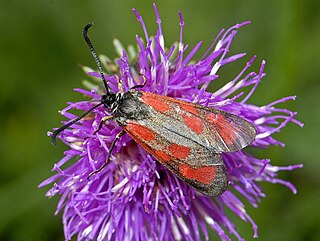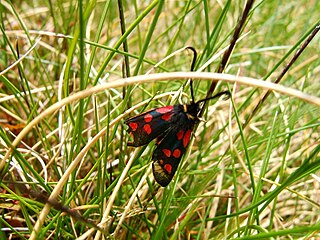
Caterpillars are the larval stage of members of the order Lepidoptera.

Lepidoptera is an order of insects that includes butterflies and moths. About 180,000 species of the Lepidoptera are described, in 126 families and 46 superfamilies, 10 per cent of the total described species of living organisms. It is one of the most widespread and widely recognizable insect orders in the world. The Lepidoptera show many variations of the basic body structure that have evolved to gain advantages in lifestyle and distribution. Recent estimates suggest the order may have more species than earlier thought, and is among the four most speciose orders, along with the Hymenoptera, Diptera, and Coleoptera.
A common classification of the Lepidoptera involves their differentiation into butterflies and moths. Butterflies are a natural monophyletic group, often given the suborder Rhopalocera, which includes Papilionoidea, Hesperiidae (skippers), and Hedylidae. In this taxonomic scheme, moths belong to the suborder Heterocera. Other taxonomic schemes have been proposed, the most common putting the butterflies into the suborder Ditrysia and then the "superfamily" Papilionoidea and ignoring a classification for moths.

In evolutionary biology, mimicry is an evolved resemblance between an organism and another object, often an organism of another species. Mimicry may evolve between different species, or between individuals of the same species. Often, mimicry functions to protect a species from predators, making it an antipredator adaptation. Mimicry evolves if a receiver perceives the similarity between a mimic and a model and as a result changes its behaviour in a way that provides a selective advantage to the mimic. The resemblances that evolve in mimicry can be visual, acoustic, chemical, tactile, or electric, or combinations of these sensory modalities. Mimicry may be to the advantage of both organisms that share a resemblance, in which case it is a form of mutualism; or mimicry can be to the detriment of one, making it parasitic or competitive. The evolutionary convergence between groups is driven by the selective action of a signal-receiver or dupe. Birds, for example, use sight to identify palatable insects, whilst avoiding the noxious ones. Over time, palatable insects may evolve to resemble noxious ones, making them mimics and the noxious ones models. In the case of mutualism, sometimes both groups are referred to as "co-mimics". It is often thought that models must be more abundant than mimics, but this is not so. Mimicry may involve numerous species; many harmless species such as hoverflies are Batesian mimics of strongly defended species such as wasps, while many such well-defended species form Mullerian mimicry rings, all resembling each other. Mimicry between prey species and their predators often involves three or more species.

A pupa is the life stage of some insects undergoing transformation between immature and mature stages. The pupal stage is found only in holometabolous insects, those that undergo a complete metamorphosis, with four life stages: egg, larva, pupa, and imago. The processes of entering and completing the pupal stage are controlled by the insect's hormones, especially juvenile hormone, prothoracicotropic hormone, and ecdysone. The act of becoming a pupa is called pupation, and the act of emerging from the pupal case is called eclosion or emergence.

The Zygaenidae moths are a family of Lepidoptera. The majority of zygaenids are tropical, but they are nevertheless quite well represented in temperate regions. Some of the 1000 or so species are commonly known as burnet or forester moths, often qualified by the number of spots, although other families also have 'foresters'. They are also sometimes called smoky moths.

Pieris oleracea, or more commonly known as the mustard white, is a butterfly in the family Pieridae native to a large part of Canada and the northeastern United States. The nearly all-white butterfly is often found in wooded areas or open plains. There are two seasonal forms, which make it distinct from other similar species. Because of climate change, populations are moving further north.

The six-spot burnet is a day-flying moth of the family Zygaenidae.

Zygaena transalpina is a moth of the family Zygaenidae.

The grapeleaf skeletonizer is a moth in the family Zygaenidae. It is widespread in the eastern half of the United States, and commonly noticed defoliating grapes, especially of the Virginia creeper. The western grapeleaf skeletonizer is very similar to and slightly larger than H. americana, but their distributions are different.

Mud-puddling, or simply puddling, is a behaviour most conspicuous in butterflies, but occurs in other animals as well, mainly insects; they seek out nutrients in certain moist substances such as rotting plant matter, mud and carrion and they suck up the fluid. Where the conditions are suitable, conspicuous insects such as butterflies commonly form aggregations on wet soil, dung or carrion. From the fluids they obtain salts and amino acids that play various roles in their physiology, ethology and ecology. This behaviour also has been seen in some other insects, notably the leafhoppers, e.g. the potato leafhopper, Empoasca fabae.

Zygaena loti, the slender Scotch burnet, is a moth of the family Zygaenidae. It is a diurnal moth characterized by a black body, light colored legs, and red spots on its wings. The caterpillars are a yellow-green color and usually molt out of dormancy in late February to early March. The larvae feed on plants from the family Fabaceae until they enter their pupal stage and mature into adults in May to early June. For mating, Zygaenidae exhibit a dual-partner finding strategy, where females use pheromones while assuming a calling position, and males exhibit a patrolling behavior where they utilize both vision and the olfactory receptors in their antennae to locate a potential mate.

Zygaena exulans, the mountain burnet or Scotch burnet, is a moth of the family Zygaenidae.
Pollanisus nielseni is a moth of the family Zygaenidae. It inhabits the Australian state of Western Australia, mostly coastal areas, and has brilliantly shiny forewings. The diurnal adults are most active on sunny days. Eggs are laid on the plant Hibbertia spicata, and females touch each egg after oviposition with a tuft of hair on their abdomen, which attaches protective spines. The larvae are brightly coloured and feed on H. spicata before pupation.

Zygaena anthyllidis is a species of moth in the Zygaenidae family. It is found in France and Spain.

Praezygaena is a genus of moths in the family Zygaenidae. The genus was established as a subgenus of Epizygaena.
Cyclosia distanti is a moth in the family Zygaenidae. It was described by Druce in 1891. It is found in Malacca.
Cyclosia panthona is a moth in the family Zygaenidae. It was described by Caspar Stoll in 1780. It is found in China, Hong Kong, India, Sri Lanka, and Myanmar.

Cyclosia papilionaris, Drury's jewel, is a moth in the family Zygaenidae. It was described by Dru Drury in 1773. It is found from Thailand to southern China. It is also found in Andaman and Nicobar Islands, India. The habitat consists of rainforests and humid deciduous forests at altitudes up to 1,000 meters.
Cyclosia pieridoides, the False Idea Moth, is a moth in the family Zygaenidae. It was described by Francis Walker in 1862. It is found in Asia.















